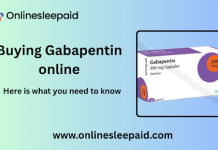Nasal congestion, commonly referred to as a stuffy or blocked nose, is a condition that many of us have experienced. It occurs when the tissues and blood vessels in the nasal passages become swollen, leading to difficulty in breathing through the nose. Nasal congestion can be caused by various factors and can range from a mild annoyance to a more significant discomfort. In this article, we’ll delve into the causes, symptoms, and effective ways to find relief from nasal congestion.
Causes of Nasal Congestion:
- Viral Infections: The most frequent cause of nasal congestion is viral infections such as the common cold or flu. These infections trigger inflammation of the nasal passages and excessive mucus production, leading to congestion.
- Allergies: Allergic reactions to substances like pollen, dust mites, pet dander, mold, or certain foods can cause the release of histamines. Histamines prompt inflammation and swelling in the nasal passages, resulting in congestion.
- Sinus Infections (Sinusitis): Sinusitis occurs when the sinuses, which are air-filled cavities around the nose, become inflamed and blocked due to infection or allergies. This can cause congestion and pressure in the face.
- Environmental Irritants: Exposure to irritants like tobacco smoke, strong odors, pollution, or chemicals can irritate the nasal passages and trigger congestion.
- Dry Air: Dry and cold air can dry out the nasal passages, making the tissues more prone to inflammation and congestion. This is often more noticeable in colder months or indoor environments with low humidity.
- Pregnancy: Hormonal changes during pregnancy can cause increased blood flow to the nasal passages, leading to swelling and congestion, a condition often referred to as “pregnancy rhinitis.”
- Foods and Spices: Some individuals may experience nasal congestion as a response to consuming certain foods or spices, particularly those that are spicy or rich in histamine.
- Structural Abnormalities: Other structural abnormalities within the nasal passages, such as nasal polyps (growths) or tumors, can lead to obstruction and congestion.
- Cold Air or Swimming: Exposure to cold air or swimming in cold water can lead to a phenomenon called “cold-induced rhinitis,” where the blood vessels in the nasal passages constrict, causing congestion.
Symptoms of Nasal Congestion:
- Difficulty Breathing: The primary symptom of nasal congestion is the sensation of difficulty in breathing through the nose. This can lead to a feeling of restricted airflow and discomfort.
- Nasal Discharge: In some cases, nasal congestion is accompanied by nasal discharge. The discharge can vary in consistency, from thin and watery to thick and colored.
- Reduced Sense of Smell: Nasal congestion often leads to a diminished sense of smell. This can affect your ability to fully enjoy food and detect scents in your environment.
- Nasal Voice: Due to the blockage in the nasal passages, your voice might sound different, often referred to as a “nasal” voice.
- Snoring: Nasal congestion can lead to snoring, especially when lying down. The restricted airflow through the nasal passages can cause vibrations in the tissues, resulting in snoring sounds.
- Postnasal Drip: Excess mucus from the congested nasal passages can drip down the back of your throat, leading to a sensation of postnasal drip. This can sometimes cause throat irritation or coughing.
- Headache and Pressure: The blocked nasal passages can result in pressure and discomfort in the sinus areas, which can lead to headaches.
- Restlessness during Sleep: Nasal congestion can disrupt sleep by causing difficulty in breathing while lying down. This may lead to restlessness or frequent waking during the night.
- Mouth Breathing: As a response to the difficulty in breathing through the nose, individuals with nasal congestion often resort to breathing through their mouths.
- Frequent Nose Blowing: Constantly needing to blow your nose to clear congestion is a common symptom.
Quick Solutions for Instant Nasal Relief
Here are some quick solutions to help you breathe freely again:
- Steam Inhalation: Inhaling steam from a bowl of hot water can provide immediate relief. Cover your head with a towel and lean over the bowl, inhaling the steam for about 5-10 minutes. The warmth helps to open up nasal passages and alleviate congestion.
- Saline Nasal Spray: A saline nasal spray is a simple and effective way to instantly moisturize and clear nasal passages. The saltwater solution helps thin mucus and ease congestion. Use it as directed on the packaging.
- Nasal Strips: Nasal strips are adhesive strips that you apply to the outside of your nose. They work by physically opening up your nasal passages, allowing for improved airflow. These can be especially helpful during sleep.
- Elevate Your Head: When lying down, prop your head up with an extra pillow. Elevating your head can prevent mucus from pooling in your nasal passages, providing relief from congestion, especially at night.
- Drink Warm Fluids: Hot beverages like herbal teas, broths, or warm water with honey and lemon can help soothe your throat and thin mucus, making it easier to clear your nasal passages.
- Humidifier: Using a humidifier in your room adds moisture to the air and prevents your nasal passages from becoming too dry, which can exacerbate congestion.
- Neti Pot or Nasal Irrigation: Using a neti pot or nasal irrigation kit with a saline solution can help flush out mucus and irritants from your nasal passages, providing quick relief from congestion.
- Essential Oils: Some essential oils, like eucalyptus or peppermint, have natural decongestant properties. Adding a few drops to a bowl of hot water and inhaling the steam can offer instant relief.
- Nasal Decongestant Spray: Use over-the-counter nasal decongestant sprays sparingly and as directed. These sprays work by constricting blood vessels in the nasal passages, providing rapid relief.
- Acupressure: Apply gentle pressure to specific acupressure points on your face, such as the sides of your nostrils, to stimulate blood flow and help clear congestion.
Essential Oils for Clearing Nasal Congestion
Here are some essential oils that are effective for clearing nasal congestion:
- Eucalyptus Oil: Eucalyptus oil is well-known for its decongestant properties. Its active compound, eucalyptol, helps to loosen mucus and ease breathing. Add a few drops to a bowl of hot water, cover your head with a towel, and inhale the steam.
- Peppermint Oil: Peppermint oil contains menthol, which provides a cooling sensation and helps clear congestion. You can dilute a few drops of peppermint oil in a carrier oil and apply it to your chest or inhale its aroma.
- Tea Tree Oil: Tea tree oil has antibacterial and antiviral properties that can support respiratory health. Mix a few drops with a carrier oil and apply it to your chest or use it in a diffuser.
- Lavender Oil: Lavender oil has anti-inflammatory properties and can help soothe irritated nasal passages. It’s often used alongside other essential oils for a relaxing and congestion-relieving aroma.
- Rosemary Oil: Rosemary oil contains camphor and cineole, which can help relieve congestion and promote clear breathing. Diffuse it in your living space or dilute it for topical use.
- Lemon Oil: Lemon oil’s citrusy scent can help open up airways and provide a refreshing feeling. Add a few drops to warm water and inhale the steam or use it in a diffuser.
- Oregano Oil: Oregano oil’s antimicrobial properties can help fight infections that contribute to nasal congestion. Use it sparingly, as it is potent. Mix a drop with a carrier oil and apply it to your feet or chest.
- Frankincense Oil: Frankincense oil has anti-inflammatory properties and can help support overall respiratory health. Its soothing aroma can also help promote relaxation.
- Cedarwood Oil: Cedarwood oil has a woodsy scent and can help alleviate congestion by promoting healthy respiratory function. Use it in a diffuser or dilute it for topical application.
- Ginger Oil: Ginger oil’s warming properties can help improve circulation and relieve congestion. You can use it in a diffuser or blend it with carrier oil for topical use.
Breathing Exercises for Nasal Relief
Here are some effective breathing exercises to provide nasal relief:
- Deep Breathing Technique: Sit or lie down comfortably. Close your eyes and take a slow, deep breath in through your nose, allowing your abdomen to rise as you fill your lungs with air. Exhale slowly and completely through your mouth. Repeat this deep breathing for several cycles, focusing on your breath and letting go of tension.
- Alternate Nostril Breathing (Nadi Shodhana): Use your right thumb to close your right nostril and inhale deeply through your left nostril. At the top of the inhalation, close your left nostril with your right ring finger and release your right nostril. Exhale through your right nostril. Inhale deeply through your right nostril, close it, and exhale through your left nostril. This completes one cycle. Repeat for several cycles, maintaining a calm and even breath.
- Humming Breath (Bhramari Pranayama): Sit comfortably with your eyes closed. Inhale deeply through your nose. As you exhale, make a gentle humming sound, like that of a bee. Feel the vibrations in your nasal passages. Continue for several breaths, focusing on the soothing vibrations and the sensation of clearing your nasal passages.
- Ujjayi Breathing: Sit or lie down comfortably. Inhale deeply through your nose while slightly constricting the back of your throat. Exhale through your nose with the same throat constriction, creating a gentle “ocean-like” sound. Ujjayi breathing can help increase lung capacity and regulate airflow.
- Diaphragmatic Breathing: Lie on your back with one hand on your chest and the other on your abdomen. Inhale deeply through your nose, allowing your abdomen to rise while keeping your chest relatively still. Exhale slowly through your nose, feeling your abdomen fall. This type of breathing engages the diaphragm and promotes deep relaxation.
- Lion’s Breath (Simhasana): Sit in a comfortable cross-legged position. Inhale deeply through your nose. As you exhale, open your mouth wide, stick out your tongue, and exhale forcefully while making a “haaaa” sound. This exercise can help release tension in the face and throat.
- Resonant Breathing: Sit comfortably and close your eyes. Inhale slowly through your nose for a count of four. Exhale slowly through your nose for a count of four. As you exhale, create a slight humming sound by narrowing the opening of your throat. Focus on the vibrations and the rhythmic flow of your breath.
When to Seek Medical Attention
. Here are some circumstances in which you should consider reaching out to a healthcare professional:
- Prolonged Congestion: If your nasal congestion persists for more than 10 days and is not improving, it could be a sign of an underlying issue such as a sinus infection or allergies that may require medical intervention.
- Severe Pain: If you experience severe pain in your sinuses, face, or head in addition to congestion, it could indicate a sinus infection or another more serious condition that needs medical assessment.
- High Fever: A fever of 100.4°F (38°C) or higher combined with nasal congestion could signal an infection that requires medical attention, especially if it’s accompanied by other symptoms like chills, body aches, or fatigue.
- Green or Yellow Mucus: While mucus color alone is not always an indicator of infection, green or yellow mucus, particularly if accompanied by other symptoms, could be a sign of a bacterial infection that may require antibiotics.
- Breathing Difficulties: If you’re having trouble breathing or experiencing shortness of breath in addition to congestion, it’s important to seek medical attention to rule out any serious respiratory issues.
- Bloody Nose: Frequent or persistent nosebleeds along with congestion may warrant a visit to a healthcare provider to rule out underlying causes like nasal infections or bleeding disorders.
- Chronic Nasal Congestion: If you experience ongoing nasal congestion that interferes with your daily life, sleep, or overall well-being, it’s a good idea to consult a healthcare professional to determine the underlying cause and explore treatment options.
- Underlying Medical Conditions: Individuals with certain medical conditions such as asthma, chronic obstructive pulmonary disease (COPD), or immune system disorders should seek medical attention if their congestion worsens or becomes difficult to manage.
- Recurrent Symptoms: If you frequently experience nasal congestion, it’s worth discussing the issue with a healthcare provider to determine the cause and develop a long-term management plan.
- Allergic Reactions: If you suspect your congestion is due to allergies and over-the-counter medications aren’t providing relief, a healthcare professional can help identify the specific allergen and recommend appropriate treatment.
Conclusion:
Nasal congestion can disrupt our comfort, concentration, and overall well-being. However, armed with the knowledge of quick and effective solutions, you can find relief and restore your ability to breathe freely. From steam inhalation and saline nasal sprays to essential oils and breathing exercises, there’s a range of methods at your disposal to unstuff your nose and alleviate discomfort.
FAQ
Q1: What causes a stuffy nose?
Ans: Inflammation in nasal blood vessels and excessive mucous secretion.
Q2: How can I relieve nasal congestion without medication?
Ans: Using a humidifier, breathing in steam, using a neti pot, saline sprays.
Q3: Should I use decongestant saline sprays?
Ans: Consult a medical professional before using them.
Q4: How long does nasal congestion typically last?
Ans: It can vary but usually resolves within a few days to a week.
Q5: What lifestyle changes can help prevent nasal congestion?
Ans: Avoiding irritants, maintaining good hygiene, and staying hydrated.








